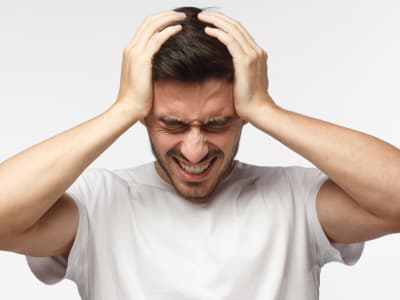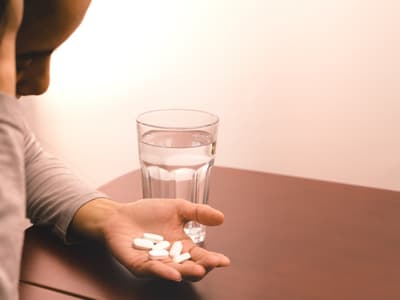Bipolar Disorder and Addiction
 The bipolar disorders are a group of complex mental health issues. Perhaps the most commonly thought-of type is characterized by extreme highs and lows in mood. Bipolar disorder is also associated with unusual or pronounced changes in energy and activity levels. Many people with bipolar disorder also abuse drugs and alcohol, which can turn into an addiction.
The bipolar disorders are a group of complex mental health issues. Perhaps the most commonly thought-of type is characterized by extreme highs and lows in mood. Bipolar disorder is also associated with unusual or pronounced changes in energy and activity levels. Many people with bipolar disorder also abuse drugs and alcohol, which can turn into an addiction.
Treatment for bipolar disorder and substance abuse can include several different types of medications and therapies. In many suspected cases of bipolar and substance use disorder, treatment is preceded by a detoxification period to confirm that the person is displaying the signs of bipolar disorder instead of drug-induced symptoms that resemble the condition.
Definition of Bipolar Disorder
Bipolar disorder is a mental health disorder that includes unusual or extreme changes in mood, energy, thought, and activity levels.1 It can have serious effects on relationships, employment, and finances. For example, expansive mood, unusual optimism, grandiosity, and poor judgment may lead to reckless behaviors such as spending too much money, giving away possessions, dangerous driving, irrational business investments, and sexual activities that are not typical for the person to engage in.2
The 2 most widely known types of bipolar disorder are bipolar I disorder and bipolar II disorder. The prevalence rate for bipolar I disorder in the U.S. is 0.6%, while the prevalence rate for bipolar II disorder is 0.8%.2
Symptoms
In order to meet criteria for bipolar I disorder, a person must experience at least 1 major depressive episode and 1 manic episode.1 Symptoms of a major depressive disorder include the following:2
- Depressed mood
- Diminished interest in usual activities
- Reduced ability to think or concentrate; difficulty making decisions
- Feeling worthless and/or guilty
- Changes in weight and/or appetite
- Alterations in sleep patterns (e.g., difficulty sleeping or sleeping much more than normal)
- Psychomotor changes (e.g., restlessness or sluggish/slow movements)
- A sense of fatigue or significantly decreased energy levels
- Thoughts of death or suicide with or without a specific plan to do so, or previous suicide attempts
The symptoms listed above must be present during the same 2-week period for someone to meet full criteria for a major depressive disorder.
A manic episode is a period of abnormally and persistently elevated, expansive, or irritable mood. It also consists of abnormally and persistently increased goal-directed activity or energy. These symptoms must be present for at least 1 week, most of the day, nearly every day.2 Additionally, at least 3 of the following symptoms must be present:2
- Exaggerated self-esteem
- Less need for sleep
- Talking more than usual
- Flood of ideas or racing thoughts
- Easily distracted
- Increased goal-directed activity, such as at work, school, or socially or sexually
- Feeling restless or pacing
- Becoming more involved than usual in risky activities such as shopping binges, reckless sexual behavior, or irrational business ventures
The criteria for bipolar II disorder is similar to that of bipolar I disorder. In order to meet full criteria for bipolar II disorder, a person must experience both a major depressive episode, as described above, and a hypomanic episode.2
A hypomanic episode is similar to a manic episode. However, rather than lasting at least 1 week, a hypomanic episode lasts at least 4 consecutive days. Someone who experiences a hypomanic episode may experience the same symptoms as someone who experiences a manic episode (listed above). But the hypomanic episode is not serious enough to greatly affect social or occupational functioning or to require hospitalization.2
Causes
Several factors may increase a person’s risk of experiencing bipolar disorder. These include:1
- Brain structure and functioning. Mania, hypomania, and/or depression may be a direct result of brain injury or a brain disease.
- Gender. Bipolar I disorder is equally likely in males and females. But bipolar II disorder is more likely in females.
- Genetics. A person whose parent has bipolar disorder is 10 times more likely to develop the disorder than someone in the general population. Specific genes increase the risk of bipolar disorder. But they do not guarantee that the person will develop it.
Bipolar and Substance Abuse
 People with bipolar disorder have a higher rate of substance use than the general population. More than half of people with bipolar I disorder have substance use disorders, and 37% of those with bipolar II disorder have substance abuse disorders.2
People with bipolar disorder have a higher rate of substance use than the general population. More than half of people with bipolar I disorder have substance use disorders, and 37% of those with bipolar II disorder have substance abuse disorders.2
Those with bipolar disorder may use substances to cope with symptoms, especially controlling mood. It has even been suggested that those struggling with bipolar disorder may select drugs based on specific mental health symptoms. For example, those struggling with aggression and rage may use opioids to calm down, while those struggling with depression may use cocaine to feel more energized.3
People who use substances may experience a decrease in symptoms initially and therefore feel they are coping with these symptoms. But in the long run they may be putting themselves at more risk. Chronic abuse and withdrawal tend to affect mood, which can lead to increased substance abuse and eventually dependence.3
Another theory suggests that chronic substance use may “unmask” bipolar disorder. This means that using a substance may lead to an increase in severity of bipolar disorder symptoms that might otherwise not have been noticeable.3 Concerned about your substance use? Take a free online substance abuse assessment today.
Consequences
When someone struggles with both a substance use disorder and bipolar disorder, it’s called a dual diagnosis. These diagnoses can be very complex and have serious outcomes. For example, research has found that people with bipolar disorder who also struggle with substance use may have an earlier age of onset of manic, hypomanic, or depressive episodes; have more frequent hospitalizations; and have other psychiatric disorders, such as anxiety or conduct disorders.3
Research has also found that those with bipolar disorder who also struggle with alcohol dependence recover more slowly than those who did not struggle with alcohol dependence. Further, those struggling with substance use and a mood disorder, such as bipolar disorder, are at a higher risk of suicide.3
It’s crucial that both disorders be treated at the same time. Integration of services for both disorders can optimize recovery.3
Treatment Process
Medication can be used to treat bipolar disorder and substance use disorder. However, a detoxification period, where the body rids itself of substances, can be helpful in verifying that the person has bipolar symptoms – as opposed to drug-induced symptoms that resemble bipolar disorder – and to reduce the risk of exposing the person to a medication and treatment expenses that may not be necessary.3
Once the body has rid itself of all substances, if depressive or manic symptoms have not gone away, then medication may be necessary.
Medication
Antidepressants, such as venlafaxine (Effexor) and bupropion (Wellbutrin), have shown promise for those struggling with both depressive symptoms and a substance use disorder.3
Anticonvulsants, such as valproate (Depakote) and carbamazepine (Tegretol), have also been used to treat bipolar disorder. They have also shown promise for the treatment of both bipolar and substance use disorders. Additionally, mood stabilizers, such as lithium, have also been found to be helpful in the treatment of dual diagnoses. In fact, research has found connections between lithium therapy, reduced drug abuse, and improved mood.3
Regardless of which medication is used, the patient should meet with the prescribing physician(s) on a regular basis to ensure that the medication is working and that there are no serious side effects.
Therapy
 Psychotherapy is another treatment option to consider, especially since the combination of both medication and psychotherapy tends to produce the best results. A variety of therapeutic techniques may be used in the treatment of both bipolar and substance use disorders, including:
Psychotherapy is another treatment option to consider, especially since the combination of both medication and psychotherapy tends to produce the best results. A variety of therapeutic techniques may be used in the treatment of both bipolar and substance use disorders, including:
- Cognitive behavioral therapy (CBT): CBT focuses on how someone’s thoughts are related to their actions and emotions. CBT may encourage a person to look at how triggers, substance use, and mood are connected, and may encourage them to think in ways that lead to healthier actions.4
- Dialectical behavior therapy (DBT): DBT is similar to CBT, but puts more of a focus on regulating emotions. The person may be encouraged to focus on how to cope with feelings, including using mindfulness and acceptance.4
- Integrated group therapy (IGT): IGT is also based on a CBT model of relapse prevention. It is a group therapy setting that simultaneously focuses on both substance use disorders and bipolar disorders, rather than one or the other.5
- Other techniques and skills, which include:
- Mood/life chart
- A mood/life chart is a record of daily symptoms, changes in mood, treatments, sleep patterns, and life events. It can help someone track, manage, and treat bipolar symptoms more effectively.1
- Exercise
- Exercise has been found to help relieve symptoms of bipolar disorder, especially depressive symptoms.1
- Education
- Education about bipolar disorder and substance use disorder can be helpful as well. Books and videos are available, as well as online resources. Learning about these disorders can help someone identify and practice new coping strategies.1
- Mood/life chart
Lastly, those struggling with bipolar disorder and substance use disorder should be assessed for suicide risk. Risk of suicide is 15 times higher in those with bipolar disorder than the general population.2 Regardless of what type of therapy a person engages in, it is crucial that their safety is clearly and thoroughly evaluated.
Recovery Options
Treatment for dual diagnoses may take place in several settings, including the following:
- Inpatient: Inpatient treatment takes place in residential settings, and typically lasts 30 to 90 days. Participants may engage in group therapy, individual therapy, family therapy, medication management, and social settings.
- Outpatient: Outpatient treatment may take place at a clinic or similar setting. It may meet once per week or several times per week. This type of treatment takes place in a group setting, although the participant may have a chance to meet individually with the counselor. The person may listen to others discuss their struggles with substance use, share their story, or meet with their family in treatment.
- 12-step programs: Examples include Alcoholics Anonymous (AA) or Narcotics Anonymous (NA), both of which also provide opportunities to listen to others who have struggled with substance use. There are also opportunities to socialize with others, seek support from others who may have a better understanding of what the person is going through, and even connect with a sponsor to help them with their recovery.
- Support groups: Lastly, people can participate in a support group for substance use, bipolar disorder, or both. Support groups may or may not be led by a professional, but they often provide an opportunity to share struggles with others while also listening to and connecting with other people who may have similar struggles.
Whether you engage in inpatient treatment, outpatient treatment, a 12-step program, a support group, or some combination of the above, find a treatment environment where you feel comfortable and safe. If you or someone you love is struggling with bipolar disorder, substance use, or both, explore your treatment options today and don’t hesitate to reach out to us with questions.
Sources
- Substance Abuse and Mental Health Services Administration. (2017). Bipolar Disorders.
- American Psychiatric Association. (2013). Diagnostic and Statistical Manual of Mental Disorders: Fifth Edition. Arlington, VA: American Psychiatric Association Publishing.
- Quello, S. B., Brady, K. T., and Sonne, S. C. (2005). Mood Disorders and Substance Use Disorder: A Complex Comorbidity. Science & Practice Perspectives, (1), 13-21.
- National Alliance on Mental Illness. (N.D.). Psychotherapy.
- National Institute on Drug Abuse. (2010). Attention to Bipolar Disorder Strengthens Substance Abuse Treatment.
